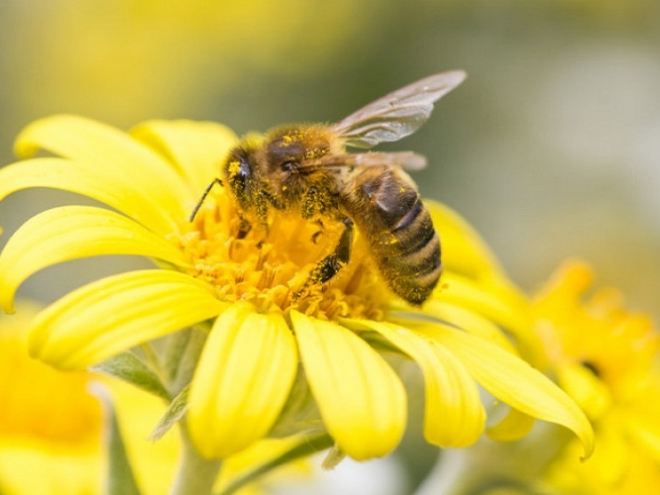Behavioral Neuroscience, lecture on Acetylcholine
Honey Bee Conditioned Drinking
X. Circuit for Learning Aversion and Reward
A. AL uniglomerular (single glomerulus) PNs to higher brain regions
1. branch into 2 (or 3) distinct tracts
2. Lateral antenno-cerebralis tract (l-APT)
a. Projects first to the lateral horn (LH)
i. LH is a sexually dimorphic brain region in arthropods
1) females respond to pheromones more
ii. connections remain ipsilateral
iii. signal is cholinergic (nAChR)
b. and to the Kenyon Cells (KCs) in the mushroom bodies (MBs)
i. MBs are composed of neuropil
1) densely packed regions
with numerous dendritic and axonal connections
2) also contains glial cell processes
3) synaptically dense
a) few cell bodies
ii. named for mushroom like appearance
1) calyx (head)
a) home of KCs
2) peduncle (stalk)
a) primarily composed of axons
c. each AL PN connects to several (~400) KCs
i. ipsilaterally
d. cholinergic (nAChR)
3. Medial antenno-cerebralis tract (m-APT)
a. First connects with MB
i. ipsilateral
ii. releases Ach (nAChR)
b. then to LH
i. ipsilateral
ii. ACh is released (nAChR)
4. Each tract is responsible for sending unique information
a. about the encountered odor
5. Multiglomerular AL PNs also exist (in small numbers)
B. AL LNs form inhibitory connections between glomeruli
1. Homogenous LNs innervate all glomeruli uniformly
2. Heterogeneous LNs relay signals to only a small subset of glomeruli
3. LNs release GABA
a. Some LNs release histamine and glutamate
(only a small number of cells)
i. both can act as inhibitory neurotransmitters in the bee brain
b. Differential inhibition at the AL glomeruli refines odor expression
C. AL PN axons form multisynaptic connections with MB lip regions
1. MB lib microglomeruli also receive GABAergic signaling
a. GABA cell bodies are in MB output lobes (negative feedback)
i. via protocerebral calycal tract (to SEG)
D. KC outputs from microglomeruli form pathways to MB peduncle
1. Axon bundles form the MB peduncle
a. Synapse on excitatory output cells: extrinsic neurons (ENs)
i. EN = premotor neuron
3. Connect to a large single MB peduncle EN: Pe-1
E. ENs differentially extend to areas of the protocerebrum (SEG)
1. Subset forms connections with adjacent cells on the ipsilateral side
2. Proportion of neurons project to the contralateral vertical lobe
3. Other neurons project bilaterally
F. Pe-1: the major MB output
1. Most important projection to LH
a. behavioral output connections
i. direct connection of Pe-1 to SEG motor unit
1) extend through LH
ii. indirect connection to motor unit
1) synapses on non-PN LH cell
a) LH neuron connects to SEG motor center
b. Pe-1 branches widely
XI. Gating Proboscis Input
A. Co-activation of olfactory (CS) and reinforcement (US) pathways
1. important for learning environmentally appropriate proboscis extension behavior
a. olfactory CS = Antenna ORN à AL PN à SEG motor
i. AL PN à LH
ii. AL PN à MB KC
iii. LH à KC
b. reinforcement US = Proboscis GRN à SEG VUMmx1 à LH
i. SEG VUMmx1 à MB KC
2. Appetitive learning requires OA actions
3. Aversive learning involves dopamine (DA)
B. Sucrose tasting of the proboscis
1. stimulates a single SEG VUM-mx1
2. VUM-mx1 secretes OA
a. Targets 3 brain regions
(same regions that are important for olfactory processing)
i. AmOA1 in AL
ii. AmOA1 on MB calyces KC
iii. AmOA1 in LH
iv. Connections are bilateral
3. Olfactory and Gustatory signals compared
a. Antenna Olfactory ORN signal to AL PN
i. blocked by AL LN GABA
1) if odor triggers more than one glomerulus
a) e.g. toxin in sucrose
ii. AL PN signal promulgated
1) if single clean odor is clear
b. Proboscis Gustatory GRN signal à VUM-mx1 à AL
i. blocked by AL LN GABA
1) if taste triggers more than one glomerulus
a) e.g. Quinine in sucrose
ii. mediated by class 4 GRN "deterent cells" response
4. AL PN signal to LH and MB KC reflects reward "match"
5. OA reward signals to KC vs DA aversive signals to KC
a. determine the strength of signal to the Pe-1
i. and to SEG motor neurons
